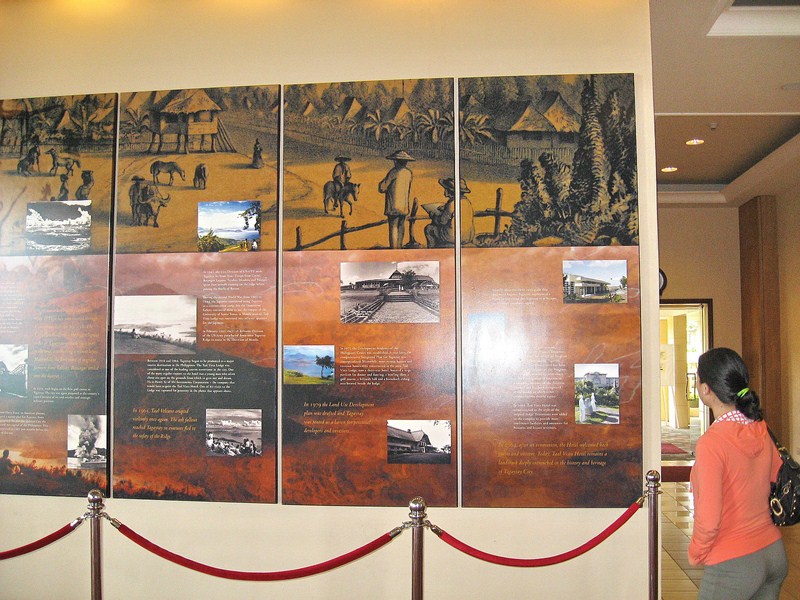 |
| Taal Vista Hotel |
A lot of my childhood memories included family visits to Tagaytay City where we enjoyed the cool and crisp (average temperature is 22.7 degrees Celsius) mountain air and a picture-pretty view of Taal Volcano from its original grand viewdeck: Taal Vista Hotel. I wanted to sample what the hotel had to offer, so I brought along my wife Grace, kids, Jandy and Cheska, plus in-laws, and stayed two nights in 2 (out of 88) interconnected superior rooms. On arrival, we were welcomed by the soft-spoken, Mr. Ikuo Itoi, and Ms Zeny Alcantara.
Check out “Hotel and Inn Review: Taal Vista Hotel“
 |
| De luxe room |
The hotel has its beginnings way back in 1935 when the Zamoras of Manila Hotel bought six hectares of flatland perched atop an incline along Ilong Kastila (people say it resembles a nose or ilong) from American Hammon H. Buck, the Superintendent of Schools in Batangas. Two years later, hotel was built. Its architect was probably Andres Luna de San Pedro who, just a few years earlier, renovated another landmark, the Manila Hotel, to accommodate a suite for Gen. Douglas MacArthur.
Its contractor was probably the well-known Pedro Soichi who built the Rizal Memorial Stadium in Manila. Both were favored by Commonwealth President Manuel L. Quezon who was then, as I still am now, equally fascinated with Tagaytay. Upon completion, Quezon frequently held cabinet meetings in the lodge’s premises and, on 21 June 1938, he converted Tagaytay into a chartered city by virtue of Commonwealth Act No. 338.
During World War II, the lodge was converted into quarters for Japanese officers. Between 1956 and 1964, Tagaytay began to be promoted as a major tourist attraction of the Philippines and Taal Vista Lodge was one of its leading attractions. n fact, the hotel was the public viewing ground to the September 28, 1965 (8 PM) major eruption of the volcano as well as mild to moderate eruptions from 1966 to 1970 (lasting from three to 65 days), and mild eruptions in 1976 (September 3 to October 23), 1977 (October 3 to 4 and November 9 to 12) and 1991. In 1973, Taal Vista Lodge, now a three-star hotel, boasted a large pavilion for dinner and dancing, a bowling alley, a golf course, a billiards hall and a horseback riding area beside the lodge.
One its many regular visitors was a young man who often chose one spot in the grounds from which he gazed out and dream. That dreamer was Henry Sy whose SM Investments Corp. would later acquire the hotel. In 2002, he had the hotel rebuilt in the style of the original lodge and added 2 new extensions on the east side of the complex to provide 128 rooms, conference facilities and amenities. In 2004, this reinvigorated and now first-class hotel welcomed back guests and visitors. Today, it remains a landmark deeply entrenched in the history and heritage of Tagaytay City.
The original building now houses the hotel’s front desk, business center, shops, ball room and meeting rooms. At the hotel foyer is the 26-ft x 8-ft. Taal Vista Hotel Historical Mural, a joint project of Paolo Alcazaren and Felix Mago Miguel.
 |
| Seasons |
However, the building’s focal point are its three food and beverage outlets: Cafe-on-the-Ridge, Season’s, and the Lobby Lounge. Both take you far beyond the plate,whether al fresco or from within, as their panoramic floor-to-ceiling glass windows allows diners to watch, aside from Taal Volcano and Lake, the fog rolling in, the captivating sunset and, at nighttime, the stars or the pinpoint lights of fishing boats and the lakeshore towns. cafe-in-the-ridge, offering a la carte & buffet service, recreates the cuisine and ambiance of two continents, featuring a menu that distinctly highlights the simple elegance of Europe, the carefree disposition of Spain and the Asian mystique was offered with live entertainment at night. Season’s, where you can dine of the finest gourmet creations made from the freshest of the season, is a classy fusion of setting and landscape, is a perfect place for intimate dinners and cozy get-togethers.
The Lobby Lounge, with its natural motifs, was an ideal rendezvous for a lazy after dinner conversation, evening interludes and winding down moments. Its well-stocked bar offers light meals, coffee or cocktails. Here, warmed by the fireplace, we all sampled hot chocolate while listening to a piano.Try sampling the Chocolate Eruption, a sinfully delicious dessert concoction prepared and baked, minutes before serving, by Canadian executive chef Bill McGrath.
 |
| Swimming pool |
The tropical style Ylang-Ylang Spa, ran by French doctor, Charles Sutter and his Filipina wife Pristine in Davao, applies all-natural techniques and ingredients rooted on the principle of “touch therapy” which has been proven to stimulate the release of endorphins which is supposed to make you happy.
The hotel is in the midst of a Php 650 million (US$16 million) expansion which will add 133 more rooms, 6 function rooms, and a 1,000-seater grand ballroom. By the end of the year, the hotel will have a total of 261 guestrooms, 2 grand ballrooms and 16 function rooms.

